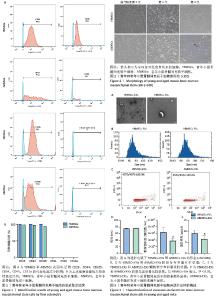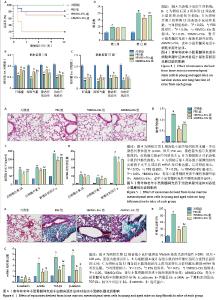Chinese Journal of Tissue Engineering Research ›› 2026, Vol. 30 ›› Issue (1): 1-9.doi: 10.12307/2025.575
Protection of exosomes derived from bone marrow mesenchymal stem cells of different mouse ages on radiation-induced lung injury
Zhang Tingting1, Li Yalong2, Yue Haodi1, Li Yanjun1, Geng Xiwen1, Zhang Yuwei1, Liu Xiaozhuan1
- 1Center for Clinical Single-Cell Biomedicine, Henan Provincial People’s Hospital, People’s Hospital of Zhengzhou University, Zhengzhou 450000, Henan Province, China; 2Stem Cell Research Center, Henan Provincial People’s Hospital, Henan Key Laboratory of Stem Cell Clinical Application and Key Technology, People’s Hospital of Zhengzhou University, Zhengzhou 450000, Henan Province, China
-
Received:2024-11-22Accepted:2025-03-04Online:2026-01-08Published:2025-06-11 -
Contact:Liu Xiaozhuan, MD, Associate research fellow, Center for Clinical Single-Cell Biomedicine, Henan Provincial People’s Hospital, People’s Hospital of Zhengzhou University, Zhengzhou 450000, Henan Province, China -
About author:Zhang Tingting, MS, Assistant research fellow, Center for Clinical Single-Cell Biomedicine, Henan Provincial People’s Hospital, People’s Hospital of Zhengzhou University, Zhengzhou 450000, Henan Province, China -
Supported by:Natural Science Foundation of Henan Province (Youth Program), No. 232300421297 (to ZTT); Key Research & Development and Promotion Project of Henan Province, No. 232102311040 (to LYL); Overseas Training Program of Henan Province (Health Science and Technology Talents), No. HWYX2019133 (to LXZ)
CLC Number:
Cite this article
Zhang Tingting, Li Yalong, Yue Haodi, Li Yanjun, Geng Xiwen, Zhang Yuwei, Liu Xiaozhuan. Protection of exosomes derived from bone marrow mesenchymal stem cells of different mouse ages on radiation-induced lung injury[J]. Chinese Journal of Tissue Engineering Research, 2026, 30(1): 1-9.
share this article
Add to citation manager EndNote|Reference Manager|ProCite|BibTeX|RefWorks

2.1 YBMSCs和ABMSCs的鉴定结果 流式细胞术检测结果显示,绝大多数细胞CD29、CD44、CD105呈阳性(阳性率大于90%),而CD34、CD45、CD11b呈阴性(阳性率小于1%),符合国际骨髓间充质干细胞标准,见图1。 如图2所示,在原代培养第3天,绝大多数YBMSCs和ABMSCs已完成贴壁,呈梭形状态。在相同量的小鼠骨髓中,ABMSCs的贴壁细胞数量少于YBMSCs。第1代培养时,贴壁生长的YBMSCs和ABMSCs胞体均已完全舒展,形态接近于成纤维细胞。第3代培养时,与YBMSCs相比,ABMSCs的胞体较扁平,少数细胞核体变大呈复制性衰老状态。 2.2 YBMSCs-EXs和ABMSCs-EXs的鉴定结果 透射电镜显示,YBMSCs-EXs和ABMSCs-EXs均呈现中间凹陷的圆盘状,见图3A。粒径分析显示YBMSCs-EXs和ABMSCs-EXs的颗粒直径大小均为75 nm左右,见图3B和图3D。YBMSCs-EXs的颗粒物浓度为6.36×109颗粒数/mL,ABMSCs-EXs的颗粒物浓度为3.78×109颗粒数/mL,两者差异有显著性意义(P < 0.05),见图3C和图3E。YBMSCs-EXs和ABMSCs-EXs的蛋白浓度也有显著差异(P < 0.05),ABMSCs-EXs的蛋白浓度(6.42 μg/μL)显著低于YBMSCs-EXs(8.98 μg/μL),见图3F。"


2.3 YBMSCs-EXs和ABMSCs-EXs对小鼠放射性肺损伤的保护作用 实验期间,对照组小鼠饮食及活动正常,呼吸平稳,无皮肤及被毛异常。而放射性肺损伤小鼠体质量减轻,活动量变少,照射区域的被毛颜色逐渐变浅直至照射后第12周全部变白,极少数小鼠出现照射野溃疡。 生存曲线显示,照射后第12周,PBS组小鼠存活率较对照组小鼠显著降低(P < 0.05)。与PBS组相比,YBMSCs-EXs组和ABMSCs-EXs组放射性肺损伤小鼠的死亡率均显著降低(P < 0.05),见图4A。 照射后第1周,PBS组小鼠肺功能相关指标与对照组相比显著下降,直至照射后第12周(均P < 0.001)。与PBS组相比,无论是在照射后第1周还是照射后第12周,YBMSCs-EXs组和ABMSCs-EXs组小鼠肺功能升高(均P < 0.05),见图4B和4C。 肺系数变化也反映了外泌体对小鼠放射性肺损伤的保护作用。如图4D所示,与对照组相比,PBS组小鼠肺系数在照射后第1周和第12周均升高(均P < 0.05)。在照射后第1周,与PBS组相比,YBMSCs-EXs组和ABMSCs-EXs组肺系数轻微降低,差异无显著性意义(P=0.08,P=0.95)。在照射后第12周,与PBS组相比,YBMSCs-EXs组和ABMSCs-EXs组肺系数均显著降低,其中YBMSCs-EXs组肺系数降低更明显(均P < 0.05)。 2.4 YBMSCs-EXs和ABMSCs-EXs对小鼠放射性肺损伤早期炎症的影响 肺组织苏木精-伊红染色显示,在照射后第1周,对照组小鼠肺组织内肺泡形态正常,未见明显炎症反应;PBS组小鼠肺组织内肺泡结构损伤,肺泡壁及肺间质充血水肿,伴有炎性细胞浸润,见图5A。与对照组相比,PBS组小鼠肺损伤指数显著升高(P < 0.05);与PBS组相比,YBMSCs-EXs组和ABMSCs-EXs组肺内炎症反应减轻,肺损伤指数显著降低,并且YBMSCs-EXs组肺损伤指数降低程度大于ABMSCs-EXs组(均P < 0.05),见图5A和图5B。 ELISA检测结果显示,照射后第1周,PBS组小鼠肺组织内促炎因子白细胞介素1β、白细胞介素6及肿瘤坏死因子α含量均显著升高(均P < 0.05),而YBMSCs-EXs组和ABMSCs-EXs组上述炎症因子水平显著降低(均P < 0.05)。YBMSCs-EXs组上述炎症因子水平的下降程度显著高于ABMSCs-EXs组(P < 0.05),见图5C。 与ELISA检测结果类似,PBS组小鼠肺组织内白细胞介素1β、白细胞介素6及肿瘤坏死因子α mRNA相对表达量升高,而YBMSCs-EXs组上述促炎因子mRNA相对表达量显著降低(均P < 0.05)。ABMSCs-EXs组小鼠肺组织内上述促炎因子mRNA相对表达量较PBS组轻微下降,差异无显著性意义(P=0.20,P=0.24,P=0.07),见图5D。 2.5 YBMSCs-EXs和ABMSCs-EXs对小鼠放射性肺损伤晚期肺纤维化的影响 Masson染色显示,照射后第12周,PBS组小鼠肺组织肺泡腔塌陷融合,肺间隔内有大量胶原沉积,而对照组小鼠肺组织内肺泡结构尚完整,胶原几乎不可见,见图6A。与对照组相比,PBS组小鼠肺组织内纤维化面积显著增加(P < 0.05),而YBMSCs-EXs组和ABMSCs-EXs组肺纤维化面积显著减少,并且YBMSCs-EXs组纤维化面积的降低程度大于ABMSCs-EXs组(均P < 0.05),见图6B。 实时荧光定量PCR结果显示,与对照组相比,PBS组小鼠肺组织内上皮细胞表面标记物E-钙黏蛋白mRNA相对表达量显著降低,而间质细胞表面标记物α-平滑肌肌动蛋白mRNA相对表达量显著升高,同时促纤维化基因转化生长因子β1和β-连环蛋白mRNA相对表达量显著升高(均P < 0.05)。YBMSCs-EXs组和ABMSCs-EXs组E-钙黏蛋白mRNA相对表达量显著升高,α-平滑肌肌动蛋白、转化生长因子β1和β-连环蛋白mRNA相对表达量显著降低(均P < 0.05)。在升高E-钙黏蛋白和降低转化生长因子β1 mRNA相对表达量上,YBMSCs-EXs具有比ABMSCs-EXs更好的效果(P < 0.05),见图6C。 "

| [1] KONKOL M, ŚNIATAŁA P, MILECKI P. Radiation-induced lung injury - what do we know in the era of modern radiotherapy? Rep Pract Oncol Radiother. 2022;27(3):552-565. [2] WANG Y, ZHANG J, SHAO C. Cytological changes in radiation-induced lung injury. Life Sci. 2024;358:123188. [3] RAHI MS, PAREKH J, PEDNEKAR P, et al. Radiation-Induced Lung Injury-Current Perspectives and Management. Clin Pract. 2021;11(3): 410-429. [4] CHANG S, LV J, WANG X, et al. Pathogenic mechanisms and latest therapeutic approaches for radiation-induced lung injury: A narrative review. Crit Rev Oncol Hematol. 2024;202:104461. [5] YAN Y, FU J, KOWALCHUK RO, et al. Exploration of radiation-induced lung injury, from mechanism to treatment: a narrative review. Transl Lung Cancer Res. 2022;11(2):307-322. [6] XU T, ZHANG Y, CHANG P, et al. Mesenchymal stem cell-based therapy for radiation-induced lung injury. Stem Cell Res Ther. 2018;9(1):18. [7] XIA C, CHANG P, ZHANG Y, et al. Therapeutic effects of bone marrow-derived mesenchymal stem cells on radiation-induced lung injury. Oncol Rep. 2016;35(2):731-738. [8] HAO Y, RAN Y, LU B, et al. Therapeutic Effects of Human Umbilical Cord-Derived Mesenchymal Stem Cells on Canine Radiation-Induced Lung Injury. Int J Radiat Oncol Biol Phys. 2018;102(2):407-416. [9] MONTAY-GRUEL P, ZHU Y, PETIT B, et al. Extracellular Vesicles for the Treatment of Radiation-Induced Normal Tissue Toxicity in the Lung. Front Oncol. 2021;10:602763. [10] ZHIDU S, YING T, RUI J, et al. Translational potential of mesenchymal stem cells in regenerative therapies for human diseases: challenges and opportunities. Stem Cell Res Ther. 2024;15(1):266. [11] YANG C, XUE Y, DUAN Y, et al. Extracellular vesicles and their engineering strategies, delivery systems, and biomedical applications. J Control Release. 2024;365:1089-1123. [12] IMAFUKU A, SJOQVIST S. Extracellular Vesicle Therapeutics in Regenerative Medicine. Adv Exp Med Biol. 2021;1312:131-138. [13] XU S, LIU C, JI HL. Concise Review: Therapeutic Potential of the Mesenchymal Stem Cell Derived Secretome and Extracellular Vesicles for Radiation-Induced Lung Injury: Progress and Hypotheses. Stem Cells Transl Med. 2019;8(4):344-354. [14] LEE BC, KANG I, YU KR. Therapeutic Features and Updated Clinical Trials of Mesenchymal Stem Cell (MSC)-Derived Exosomes. J Clin Med. 2021;10(4):711. [15] 林美玉,姚翔,高景,等.年轻和老年小鼠脂肪来源干细胞生物学特性对比[J].中国组织工程研究,2025,29(19):4063-4068. [16] WILSON A, SHEHADEH LA, YU H, et al. Age-related molecular genetic changes of murine bone marrow mesenchymal stem cells. BMC Genomics. 2010;11:229. [17] WAGNER W, BORK S, HORN P, et al. Aging and replicative senescence have related effects on human stem and progenitor cells. PLoS One. 2009;4(6):e5846. [18] CARP DM, LIANG Y. Universal or Personalized Mesenchymal Stem Cell Therapies: Impact of Age, Sex, and Biological Source. Cells. 2022; 11(13):2077. [19] DING Q, LIU G, ZENG Y, et al. Glycogen synthase kinase‑3β inhibitor reduces LPS‑induced acute lung injury in mice. Mol Med Rep. 2017; 16(5):6715-6721. [20] LI Y, SHEN Z, JIANG X, et al. Mouse mesenchymal stem cell-derived exosomal miR-466f-3p reverses EMT process through inhibiting AKT/GSK3β pathway via c-MET in radiation-induced lung injury. J Exp Clin Cancer Res. 2022;41(1):128. [21] CHEN Y, LIU X, TONG Z. Mesenchymal Stem Cells in Radiation-Induced Pulmonary Fibrosis: Future Prospects. Cells. 2022;12(1):6. [22] FRAILE M, EIRO N, COSTA LA, et al. Aging and Mesenchymal Stem Cells: Basic Concepts, Challenges and Strategies. Biology (Basel). 2022; 11(11):1678. [23] HANANIA AN, MAINWARING W, GHEBRE YT, et al. Radiation-Induced Lung Injury: Assessment and Management. Chest. 2019;156(1): 150-162. [24] BENSENANE R, HELFRE S, CAO K, et al. Optimizing lung cancer radiation therapy: A systematic review of multifactorial risk assessment for radiation-induced lung toxicity. Cancer Treat Rev. 2024;124:102684. [25] YUE T, LI D. Senescent Stem Cell Dysfunction and Age-Related Diseases. Stem Cells Dev. 2023;32(19-20):581-591. [26] RUI C, CHAN MKS, SKUTELLA T. Stem Cell Therapies and Ageing: Unlocking the Potential of Regenerative Medicine. Subcell Biochem. 2024;107:117-128. [27] SELLE M, KOCH JD, ONGSIEK A, et al. Influence of age on stem cells depends on the sex of the bone marrow donor. J Cell Mol Med. 2022; 26(5):1594-1605. [28] MAS-BARGUES C, ALIQUE M. Extracellular Vesicles as “Very Important Particles” (VIPs) in Aging. Int J Mol Sci. 2023;24(4):4250. [29] YIN Y, CHEN H, WANG Y, et al. Roles of extracellular vesicles in the aging microenvironment and age-related diseases. J Extracell Vesicles. 2021;10(12):e12154. [30] ROMERO-GARCÍA N, MAS-BARGUES C, HUETE-ACEVEDO J, et al. Extracellular Vesicles and Cellular Ageing. Subcell Biochem. 2023;102: 271-311. [31] LAZO S, NOREN HOOTEN N, GREEN J, et al. Mitochondrial DNA in extracellular vesicles declines with age. Aging Cell. 2021;20(1): e13283. [32] ZHANG WY, WEN L, DU L, et al. S-RBD-modified and miR-486-5p-engineered exosomes derived from mesenchymal stem cells suppress ferroptosis and alleviate radiation-induced lung injury and long-term pulmonary fibrosis. J Nanobiotechnology. 2024;22(1):662. [33] ROY S, SALERNO KE, CITRIN DE. Biology of Radiation-Induced Lung Injury. Semin Radiat Oncol. 2021;31(2):155-161. [34] BEACH TA, FINKELSTEIN JN, CHANG PY. Epithelial Responses in Radiation-Induced Lung Injury (RILI) Allow Chronic Inflammation and Fibrogenesis. Radiat Res. 2023;199(5):439-451. [35] 张婷婷,周建炜,岳浩迪,等.放射性肺损伤中肺Ⅱ型上皮细胞的动态表型及其在纤维化形成中的作用机制研究[J].中华放射医学与防护杂志,2022,42(6):422-427. [36] LIU X, ZHANG T, ZHOU J, et al. β-Catenin/Lin28/let-7 regulatory network determines type II alveolar epithelial stem cell differentiation phenotypes following thoracic irradiation. J Radiat Res. 2021;62(1):119-132. [37] LI Y, HE Y. Therapeutic applications of stem cell-derived exosomes in radiation-induced lung injury. Cancer Cell Int. 2024;24(1):403. [38] NOREN HOOTEN N, BYAPPANAHALLI AM, VANNOY M, et al. Influences of age, race, and sex on extracellular vesicle characteristics. Theranostics. 2022;12(9):4459-4476. [39] GAO Y, WANG C, JIN F, et al. Therapeutic effect of extracellular vesicles from different cell sources in traumatic brain injury. Tissue Cell. 2022;76:101772. [40] SUN Y, SUN Y, CHEN S, et al. Hypoxic preconditioned MSCs-derived small extracellular vesicles for photoreceptor protection in retinal degeneration. J Nanobiotechnology. 2023;21(1):449. [41] AHMADI M, REZAIE J. Ageing and mesenchymal stem cells derived exosomes: Molecular insight and challenges. Cell Biochem Funct. 2021;39(1):60-66. [42] PARK KS, BANDEIRA E, SHELKE GV, et al. Enhancement of therapeutic potential of mesenchymal stem cell-derived extracellular vesicles. Stem Cell Res Ther. 2019;10(1):288. |
| [1] | Yin Yongcheng, Zhao Xiangrui, Yang Zhijie, Li Zheng, Li Fang, Ning Bin. Effect and mechanism of peroxiredoxin 1 in microglial inflammation after spinal cord injury [J]. Chinese Journal of Tissue Engineering Research, 2026, 30(5): 1106-1113. |
| [2] | Liu Kexin, , Hao Kaimin, Zhuang Wenyue, , Li Zhengyi. Autophagy-related gene expression in pulmonary fibrosis models: bioinformatic analysis and experimental validation [J]. Chinese Journal of Tissue Engineering Research, 2026, 30(5): 1129-1138. |
| [3] | Zhang Di, Zhao Jun, Ma Guangyue, Sun Hui, Jiang Rong. Mechanism of depression-like behavior in chronic social defeat stress mice based on high-throughput sequencing [J]. Chinese Journal of Tissue Engineering Research, 2026, 30(5): 1139-1146. |
| [4] | Li Haojing, Wang Xin, Song Chenglin, Zhang Shengnan, Chen Yunxin. Therapeutic efficacy of extracorporeal shock wave therapy in the upper trapezius muscle area combined with exercise control training in patients with chronic non-specific neck pain [J]. Chinese Journal of Tissue Engineering Research, 2026, 30(5): 1162-1170. |
| [5] | Liu Yu, Lei Senlin, Zhou Jintao, Liu Hui, Li Xianhui. Mechanisms by which aerobic and resistance exercises improve obesity-related cognitive impairment [J]. Chinese Journal of Tissue Engineering Research, 2026, 30(5): 1171-1183. |
| [6] | Yu Huifen, Mo Licun, Cheng Leping. The position and role of 5-hydroxytryptamine in the repair of tissue injury [J]. Chinese Journal of Tissue Engineering Research, 2026, 30(5): 1196-1206. |
| [7] | Wen Xiaolong, Weng Xiquan, Feng Yao, Cao Wenyan, Liu Yuqian, Wang Haitao. Effects of inflammation on serum hepcidin and iron metabolism related parameters in patients with type 2 diabetes mellitus: a meta-analysis [J]. Chinese Journal of Tissue Engineering Research, 2026, 30(5): 1294-1301. |
| [8] | Chen Yixian, Chen Chen, Lu Liheng, Tang Jinpeng, Yu Xiaowei. Triptolide in the treatment of osteoarthritis: network pharmacology analysis and animal model validation [J]. Chinese Journal of Tissue Engineering Research, 2026, 30(4): 805-815. |
| [9] | Yu Shiyu, Yu Sutong, Xu Yang, Zhen Xiangyan, Han Fengxuan. Advances in research and application of tissue engineering therapeutic strategies in oral submucous fibrosis [J]. Chinese Journal of Tissue Engineering Research, 2026, 30(4): 936-948. |
| [10] | Zhang Zhaowei, Chen Ouzile, Bai Mingru, Wang Chenglin. Therapeutic potential of bioactive substances secreted by dental mesenchymal stem cells for bone repair [J]. Chinese Journal of Tissue Engineering Research, 2026, 30(1): 163-174. |
| [11] | Liu Nian, Dong Xinyue, Wang Songpeng, Xu Yingjiang, Zhang Xiaoming. Stem cell exosomes and biomaterial-assisted exosomes in bone defect repair [J]. Chinese Journal of Tissue Engineering Research, 2026, 30(1): 175-183. |
| [12] | Lyu Ruyue, Gu Lulu, Liu Qian, Zhou Siyi, Li Beibei, Xue Letian, Sun Peng. Regulatory mechanisms of exosome secretion and its application prospects in biomedicine [J]. Chinese Journal of Tissue Engineering Research, 2026, 30(1): 184-193. |
| [13] | Liu Yu, Gong Senyi, Yang Lihua, Li Weifeng, Hu Yuwen, Yan Qinbiao, Guo Meijin. Isolation, identification, and application of exosomes derived from mesenchymal stem cells [J]. Chinese Journal of Tissue Engineering Research, 2026, 30(1): 194-203. |
| [14] | Luo Wenbin, Li Ruoyun, Pan Chaofan, Luo Changjiang. Engineered exosomes for repairing tissue damage: application potential, excellent biological stability, and targeting specificity [J]. Chinese Journal of Tissue Engineering Research, 2026, 30(1): 204-217. |
| [15] | Yu Manya, Cui Xing. Contribution and interaction of various cells in bone marrow microenvironment to exosomal circular RNA associated with multiple myeloma bone disease [J]. Chinese Journal of Tissue Engineering Research, 2026, 30(1): 101-110. |
| Viewed | ||||||
|
Full text |
|
|||||
|
Abstract |
|
|||||